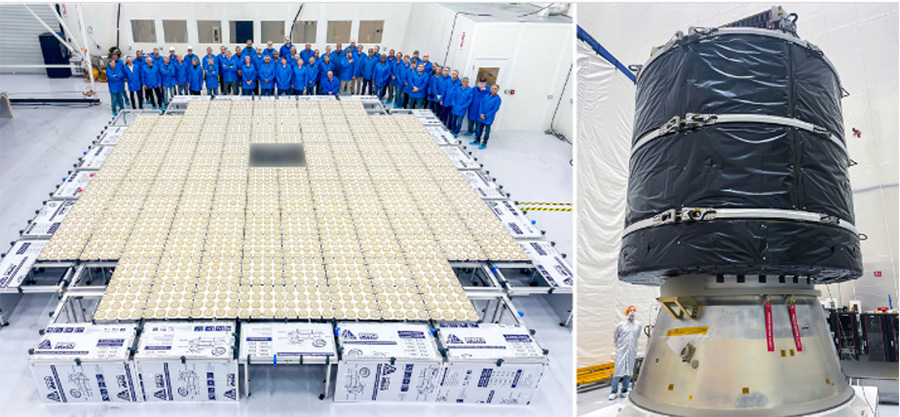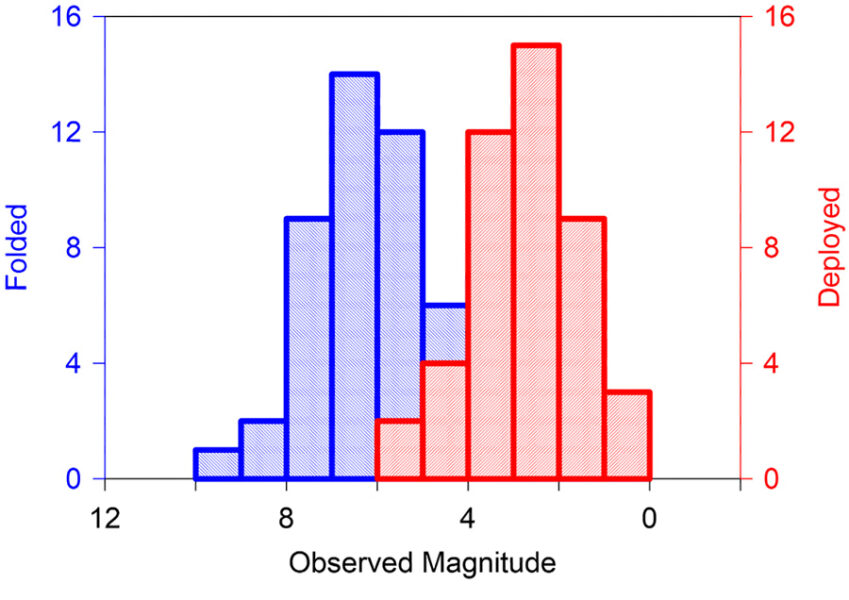16.11.2022
The satellite's array is about the same size as a small apartment.

AST SpaceMobile's BlueWalker 3 satellite deployed the largest commercial communications array ever in low Earth orbit on Nov. 14, 2022. (Image credit: AST SpaceMobile)
A record-breaking communication array just unfurled in space.
AST SpaceMobile announced on Monday (Nov. 14) that its prototype BlueWalker 3 satellite had deployed its array. The milestone comes about two months after BlueWalker 3 launched to orbit atop a SpaceX Falcon 9 rocket, along with a set of SpaceX's Starlink internet satellites.
AST SpaceMobile bills BlueWalker 3's gear as the largest commercial communications array ever deployed in low Earth orbit; its area is 693 square feet (64 square meters), or roughly the size of a small apartment.
That large size is needed to test the space-based cellular broadband service that AST SpaceMobile wants to deliver. The company is engaged in an ongoing race for direct-to-cellphone service that also involves SpaceX, OneWeb and Amazon, to name a few of the more prominent examples.
"Every person should have the right to access cellular broadband, regardless of where they live or work. Our goal is to close the connectivity gaps that negatively impact billions of lives around the world," Abel Avellan, chair and CEO of AST SpaceMobile, said in a statement(opens in new tab) on Monday (Nov. 14). The company was not immediately available for comment on the deployment success, when asked by Space.com.

BlueWalker 3 is a pathfinder for AST SpaceMobile's planned "Bluebird" satellites, which will use similarly large arrays to interface with mobile phones directly. Some astronomers have said the size of each array could contribute to light pollution issues in orbit — concerns that have also been voiced about megaconstellations such as SpaceX's Starlink, which consists of more than 3,200 spacecraft and continues to grow. (In 2020, NASA raised concerns that AST SpaceMobile satellites could add to the ever-growing risk of collisions in orbit, too.)
More than 100 Bluebird satellites are expected to be aloft by 2024. Astronomers with the Vera Rubin Observatory and the International Astronomical Union have been among those raising alarms about the constellation's potential effect on dark sky observing, Sky&Telescope reported(opens in new tab) in September. New Scientist(opens in new tab) added that the BlueWalker 3 test satellite could even outshine the brightest planet (Venus) in Earth's night sky. (AST SpaceMobile's perspective on the matter was not quoted in either article.)
In the hours after its deployment, BlueWalker 3 was easily spotted in a set of Portuguese meteor cameras, one astronomer reported on Twitter, and other scientists have been chiming in with their own concerns.
Related: Challenge for astronomy: Megaconstellations becoming the new light pollution
Why #BlueWalker3 by @AST_SpaceMobile is a BAD idea:1 - The radio service they are using has no standing in international law,2 - The use of large bright satellites effects everyone on the planet and limits the use of Earth for astronomy. Not investment advice, common sense. pic.twitter.com/jptDbg1Z5SNovember 12, 2022
In the next few months, AST SpaceMobile will begin a test program across six continents with several network operators (such as Vodafone), provided it continues to secure the necessary regulatory approvals, company representatives said in the release.
Other mobile network operators in the program include, but are not limited to, Rakuten Mobile, AT&T, Bell Canada, Telecom Argentina, Africell, Liberty Latin America and Orange, spanning a potential 1.8 billion existing subscribers, AST SpaceMobile added.
Other companies are hopping on board the cellular space trend, with Lynkplanning to test an experimental 5G cellular base station as soon as December, if earlier predictions from October come to fruition. Lynk has an approved plan from the U.S. Federal Communications Commission (FCC) to test this out. Its largest competitor, SpaceX, has an agreement in principle with T-Mobile that was announced this summer, despite not having yet secured FCC approval.
Quelle: SC
+++
Giant satellite outshines stars, sparking fresh concerns for astronomers
Transmissions from BlueWalker 3 also pose threat to radio observatories

Since launching in September, the communications satellite BlueWalker 3 has orbited Earth, curled up as if in a cocoon. Now, it has hatched, unfurling an antenna array as big as a highway billboard, its maker, Texas-based AST SpaceMobile, announced today. Astronomers say the satellite’s brightness has spiked by a factor of 40, rivaling the brightest stars in the sky.
“It’s like exactly what astronomers don’t want,” says astronomer Meredith Rawls of the University of Washington, Seattle, who helps run the International Astronomical Union’s Centre for the Protection of the Dark and Quiet Sky from Satellite Constellation Interference. “It’ll show up as a superbright streak in images and potentially saturate camera detectors at observatories.”
Thousands of commercial satellites already litter low-Earth orbit. The 64-square-meter BlueWalker 3 is the largest one yet, considerably brighter than any of the Starlink satellites deployed by SpaceX, says astronomer John Barentine of Dark Sky Consulting. On top of the light pollution, BlueWalker 3 is testing a transmission technology that threatens to trespass into the frequencies used by radio observatories on Earth, he says. “This just fundamentally feels different,” he says. “We’re in new territory here.”
AST SpaceMobile hopes the satellite will pave the way for the first space-based cellular broadband network, improving coverage by transmitting radio waves directly between satellites and mobile phones rather than relaying signals through cell towers. To reach phones on the ground, the satellite uses a large, reflective antenna roughly the size of a racquetball court that twinkles brightly as it orbits.
BlueWalker 3 is a prototype for a constellation of 168 even larger satellites called BlueBirds. AST SpaceMobile CEO Abel Avellan has argued his fleet, which would pale in comparison with the tens of thousands of planned Starlink crafts, won’t interfere with optical astronomy. But Barentine says even a small crew of these larger, flashier orbiters will obstruct ground-based telescopes’ ability to detect space objects—including potentially hazardous asteroids.
There are even brighter objects in the sky with a history of photobombing telescopes. For example, the International Space Station (ISS) is typically about 40 times brighter than recent observations of BlueWalker 3. But astronomers have real-time access to the precise location of the ISS, allowing them to reorient their cameras or close the shutters when it passes by. AST SpaceMobile has yet to respond to astronomers’ requests to clue them into its satellite’s whereabouts—nor did it respond to a request for comment on this article. “We’re trying to do this in a spirit of cooperation,” Barentine says, “but there are still a lot of companies that we just haven’t heard from yet.”
Optical astronomers aren’t the only researchers threatened. The direct-to-mobile cell service that BlueWalker 3 and its successors aim to provide requires a much stronger beam and broader use of the radio spectrum than existing networks, sparking concern among radio astronomers. On Earth, various regulatory bodies prohibit companies from operating in protected “radio-quiet zones” and from using certain frequencies that radio observatories use to probe the universe. But those regulations don’t apply to space.
“[Direct-to-mobile technology] is something that just shouldn’t happen in terms of radio astronomy,” says Harvey Liszt, a radio astronomer at the National Radio Astronomy Observatory. “The spectrum use just becomes a complete free-for-all … and at that point, the whole universe is just bright for radio astronomers.”
Liszt and his colleagues filed a complaint with the Federal Communications Commission (FCC) in December 2020, shortly after AST SpaceMobile proposed testing direct-to-mobile transmission in Hawaii and Texas. FCC ultimately granted an experimental license to BlueWalker 3, but it still hasn’t approved the proposal for the larger fleet of BlueBirds.
The underlying issue, Barentine says, is that policies regulating transmission from space were written in the 1960s, before constellations of private satellites became commercially feasible. “The system that we have right now is not very well equipped to deal with a scenario like this, which is barreling forward at full speed,” he says.
Astronomers are pinning their hopes on extending environmental protections to space. The National Environmental Policy Act requires U.S. agencies to consider environmental impacts before approving projects, but satellite licenses have been exempted because space wasn’t considered part of Earth’s environment. That assumption is now being challenged. On 2 November, the U.S. Government Accountability Office (GAO) urged FCC to re-examine how the act applies to satellite constellations. The day after the GAO report, FCC announced the creation of its new Space Bureau and Office of International Affairs. Barentine hopes it’s a signal of “the beginning of a shift in the oversight of U.S. commercial activities in space.”
For now, astronomers must learn to share the skies with the shiny machines. “This is the water we swim in,” Liszt says. “All we want everybody to do is stay in their own lane.”
Quelle: AAAS
----
Update: 18.11.2022
.
BLUEWALKER 3 SATELLITE UNFOLDS, BRIGHTENING 40-FOLD
The unfolding of the BlueWalker 3’s giant flat-panel antenna array resulted in a satellite 40 times as bright, outshining most stars.
The prototype of a new constellation of very bright Earth-orbiting satellites, named BlueWalker 3, was launched on September 11th, and as of a few days ago, it has brightened considerably. The AST SpaceMobile company behind the launch plans to orbit at least 100 more satellites like BlueWalker 3 by the end of 2024.
Amateur astronomers are concerned that the constellation of satellites will detract from the beauty of the starry skies; for professional astronomers, the satellites will interfere with scientific observations of faint objects. This new constellation would add to the numerous spacecraft already crowding the heavens.

AST SpaceMobile
The BlueWalker 3 spacecraft is so large it had to be folded up to fit in its rocket before launch. The satellite was designed to unfold itself after ground controllers had completed on-orbit testing. When fully deployed, its giant flat-panel antenna array spans 64 square meters (689 square feet).
In response to the concerns of sky watchers, Sky & Telescope invited readers to record the brightness of BlueWalker 3 before and after unfolding. Characterization of satellite brightness provides information for observers wanting to avoid the brightest spacecraft. Brightness measurements also provide feedback to engineers in order to make satellites fainter.
Visual magnitudes recorded by backyard observers and CCD magnitudes obtained at professional observatories have already been used to study the brightness of the thousands of Starlink satellites launched by SpaceX since 2019. Visual findings are directly applicable to the appearance of satellites in the sky as seen by amateur astronomers and others who view the heavens. CCD magnitudes are generally filtered to isolate brightness at specific wavelengths, so they apply more directly to the impact of satellites on astronomical research.
Observers began sending me reports just a few days after BlueWalker 3 was launched. In addition to the magnitudes recorded by Sky & Telescope readers, I also collected data from the SeeSat email archive and other public sources of satellite information. Early results indicated that the satellite in its folded-up configuration was relatively faint, with magnitudes generally between 4 and 8, depending on the distance to the satellite as well as its illumination by the Sun.
Then, on the morning of November 11th, Scott Harrington in Arkansas and Paul Maley in Arizona reported that the satellite had suddenly become much brighter. They recorded magnitudes 1.5 and 1.0, respectively, as BlueWalker 3 passed overhead. These observations indicate that the flat-panel array had been deployed, reflecting much more sunlight. Scott and Paul added more observations to the database every morning through November 14th. Richard Cole processed much of the data during that time.
Deployment resulted in about a 4-magnitude change; that is, the satellite became 40 times brighter in the sky. This study confirmed that this satellite and the constellation of similar satellites to follow will pose problems for amateur and professional astronomers. The follow-on satellites, called BlueBirds, are expected to be even larger than BW3, so they will likely be brighter, too, unless AST SpaceMobile changes their design.

Quelle: Sky&Telescope
